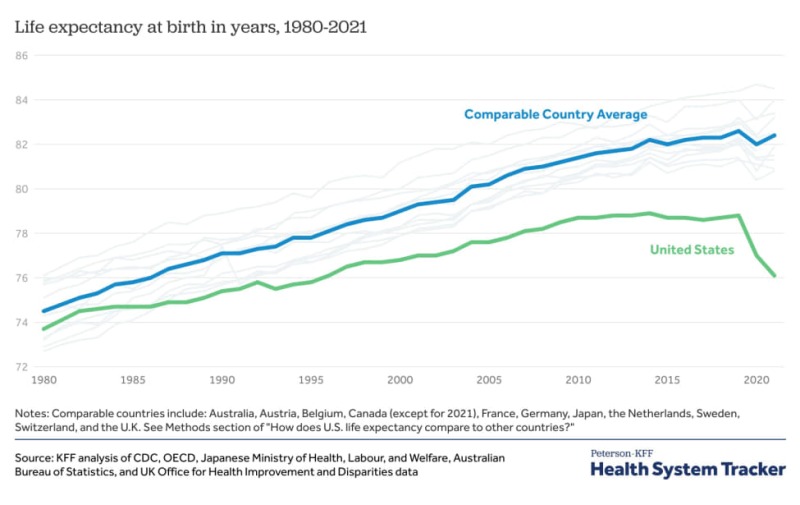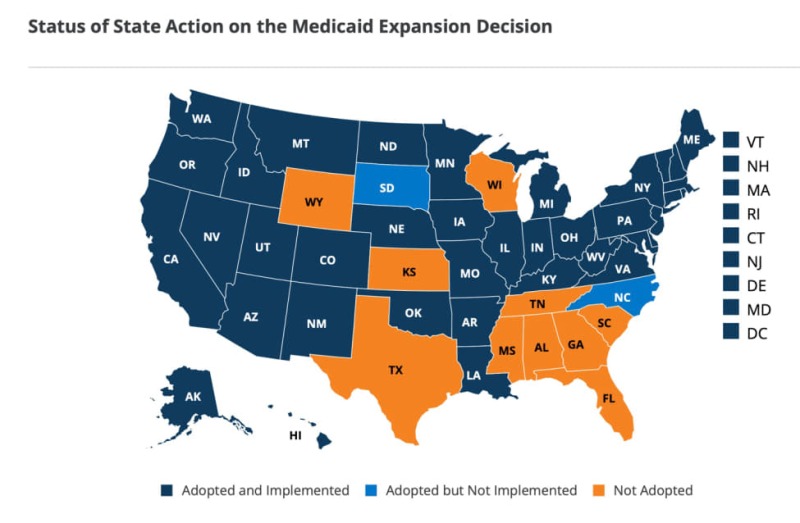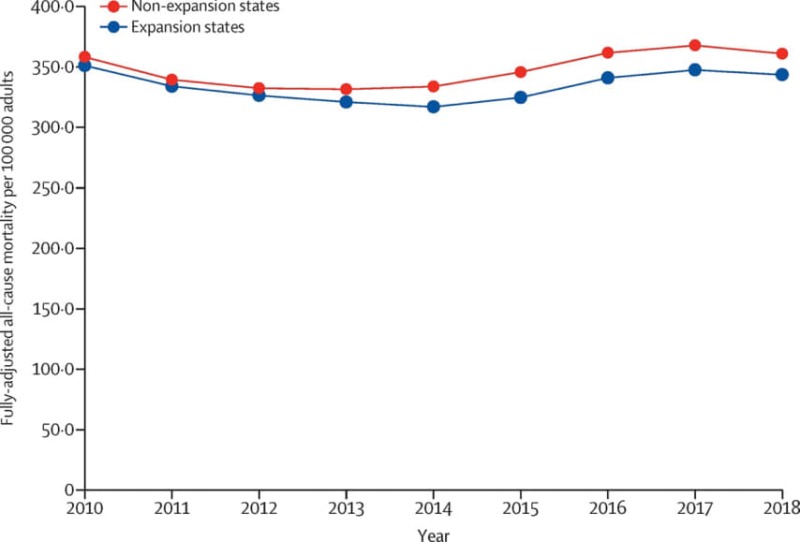“Across the lifespan, and across every demographic group, Americans die at younger ages than their counterparts in other wealthy nations.”
(“‘Live free and die?’ The sad state of U.S. life expectancy,”
https://www.npr.org/sections/health-shots/2023/03/25/1164819944/live-free-and-die-the-sad-state-of-u-s-life-expectancy)

The NPR article quoted above maps the story. Other countries see life expectancy rising again after Covid. Not America. Life expectancy in the US has continued to plummet. Take a look at the data from Peterson–KFF, cited in the NPR article (to click various lines and identify associated countries, visit the link beneath the screenshot):

(“Life Expectancy,” Peterson-KFF, https://www.healthsystemtracker.org/indicator/health-well-being/life-expectancy/#Life%20expectancy%20at%20birth%20in%20years,%202021)
One has to ask why Americans are willing to sacrifice years of their lives while those in other developed countries do not do so. Example: Life expectancy in the UK is five years longer than it is in US now. (Subscribers to the Times can read more about where the UK stands three years into the pandemic here: “Covid three years on: How the pandemic changed Britain,” https://www.thetimes.co.uk/article/covid-three-years-how-pandemic-changed-britain-wxbg7xgrv). Here’s a real surprise statistic: Cubans now enjoy a longer life expectancy than Americans do, by one year.
When states and their government officials attack public health relentlessly, this is the result — more deaths and at younger ages. Readers can further explore comparative life-expectancy data from the World Bank here: “Life Expectancy at Birth, Total (Years),” https://data.worldbank.org/indicator/SP.DYN.LE00.IN.
Within the US, there are wide disparities in life expectancy depending on where people live, their economic means, and their racial/ethnic group. Researcher Jeremy Nay maps those gaping inequalities — as much as 15 years’ difference in life expectancy at birth — at American Inequality. See “Life Expectancy and Inequality,” https://americaninequality.substack.com/p/life-expectancy-and-inequality.
There are many questions.
1. Have the medical and healthcare disinformationistas succeeded in killing thousands more Americans than would have perished without their baleful efforts? Counter factual notwithstanding, It would seem that the answer is yes, judging by the results.
2. Do certain “medical freedom” politicians actually realize that they are responsible for many deaths of their constituents? Maybe. We do see higher deaths among populations of states and counties where vaccination rates are lower. See "Study Finds Large Gap in Excess Deaths Along Partisan Lines After COVID-19 Vaccines Introduced,” https://ysph.yale.edu/news-article/study-finds-large-gap-in-excess-deaths-along-partisan-lines-after-covid-19-vaccines-introduced/.
3. Is the growing shortage of healthcare workers contributing to the decline in US lifespans? The shortage is deeply concerning, as recent Senate health committee testimony confirms. KHN’s Michael McAuliff summarizes the forecast: “The nation faces a shortfall of about 450,000 nurses and 120,000 doctors in the coming years, and 100,000 dentists now” (“Lawmakers stress urgency of healthcare worker shortage,” https://khn.org/news/article/health-care-worker-shortage-senate-hearing/). There appears to be bipartisan support for addressing the problem.
For a detailed discussion of the shortages of healthcare workers, see this link: “How has health sector employment recovered since the pandemic?” https://www.healthsystemtracker.org/chart-collection/what-impact-has-the-coronavirus-pandemic-had-on-healthcare-employment/.
Currently, long waits at ERs imperil lives when timely treatment is of the essence: “U.S. Hospitals Under Strain as ER Wait Times Lengthen,” https://www.usnews.com/news/health-news/articles/2022-10-11/u-s-hospitals-under-strain-as-er-wait-times-lengthen.
A study out of the UK has correlated ER wait times with deaths occurring within 30 days of an ER visit:
The investigators found that the death rate within 30 days for patients who are eventually admitted starts to rise five hours after arrival. When the wait times rose to between six and eight hours, the death rate was 8% higher than expected, while waiting eight to 12 hours the death rate was 10% higher than expected, compared with patients who were moved along within six hours. That meant an additional person died for every 82 patients delayed for six to eight hours.
(“Long emergency room waits may raise risk of death,” https://www.upi.com/Health_News/2022/01/19/emergency-room-delays-death-risk/9731642622635/)
Beyond impacting hospital care, a shortage of professional caregivers strains nursing homes and sidelines workers who must leave their jobs to provide care for loved ones at home full-time. The number of workers who leave the workforce to provide care for someone else is second only to the number of workers who leave to retire (“Nurses on strike are just the tip of the iceberg. The care worker shortage is about to touch every corner of the U.S. economy,” https://fortune.com/2023/02/23/nurses-on-strike-are-just-the-tip-of-the-iceberg-the-care-worker-shortage-is-about-to-touch-every-corner-of-the-u-s-economy/). That’s a sizable drain on the labor force and ultimately on GDP.
4. Besides Covid, we’re beginning to see the results of the persistent anti-vaccination, anti-public health movement in diseases like measles. Vaccination rates against measles and other childhood diseases are gradually eroding (“Decreasing rates of childhood immunization are a major concern. Our medical analyst explains why,” https://www.cnn.com/2023/01/18/health/vaccine-childhood-pediatrics-immunizations-measles-polio-health-wellness/index.html).
Avoidable outbreaks among the unvaccinated are the result: “Ohio measles outbreak sickens at least 50 kids, all unvaccinated,” https://www.cidrap.umn.edu/measles/ohio-measles-outbreak-sickens-least-50-kids-all-unvaccinated.
See also, “Is Kentucky Protected from Measles?” https://www.precisionvaccinations.com/kentucky-protected-measles.
As of 2021, 10 US states had more than 10% of children enrolling in kindergarten without having had their routine childhood vaccinations, including the MMR shot for measles, mumps, and rubella. Those states were Minnesota (89%), New Hampshire (88.7%), Colorado (88.4%), Ohio (88.3%), Kentucky (86.5%), Idaho (83.9%), Georgia (83.2%), Wisconsin (82.6%), DC (82.0%), and Alaska (78.0%) (“Slide in measles vaccination rate among kindergartners raises alarm,” https://www.washingtonpost.com/health/2023/01/12/childhood-vaccination-rates-measles-chickenpox-polio/).
5. Polio was nearly eradicated worldwide but has recently reappeared. The polio vaccine is also a target of anti-vaccination propaganda. Meanwhile, poliovirus is spreading in the US. Here’s a short reading list on that topic:
Global Polio Alert Expanded
https://www.precisionvaccinations.com/2023/03/23/global-polio-alert-expanded
“More States Consider Wastewater Surveillance for Polio,”
https://www.medpagetoday.com/special-reports/features/102397
“Can 19,200 Vaccinations Stop Polio?”
https://www.precisionvaccinations.com/2023/03/28/can-19200-vaccinations-stop-polio
The anti-vaccine disinformation spreaders have succeeded in suppressing polio vaccination numbers. Results are exactly what one would expect.
“Polio Outbreaks March 2023,”
https://www.precisionvaccinations.com/polio-outbreaks-march-2023-0
6. Did the actions of states to refuse Medicaid expansion for their citizens contribute to the falling life expectancy? The Kaiser Family Foundation offers an open-source map showing the status of Medicaid expansion in each state. Access the link below the map to pull up the clickable version with further information.

(“Status of State Medicaid Expansion Decisions: Interactive Map,” https://www.kff.org/medicaid/issue-brief/status-of-state-medicaid-expansion-decisions-interactive-map/)
A 2021 open-access study published in The Lancet documents the mortality data for states that expanded Medicaid and those that didn’t. A single chart captures the big picture, even before the pandemic:

(Brian P. Lee, Jennifer L. Dodge, and Norah A. Terrault, “Medicaid expansion and variability in mortality in the USA: a national, observational cohort study,” https://www.thelancet.com/journals/lanpub/article/PIIS2468-2667(21)00252-8/fulltext)
Readers are invited to examine this subject in greater detail on their own. In my view, American culture-war politics have become a destructive force and now contribute to lowered life expectancy and more sickness and suffering among people who are victims of social media manipulation and disinformation. The statistics from demographic data sources are accurate and reveal the trends.
Economic implications of declining life expectancy, healthcare worker shortages, and rising disease rates are monumental. They change the outlook for our nation in detrimental ways. The subject is not pleasant. Until something changes in the nation’s health system, the trends discussed above are likely to worsen.
We remain overweighted in the healthcare sector investment allocation in our US Equity ETF portfolio. Some of the reasons are listed above.
David R. Kotok
Chairman & Chief Investment Officer
Email | Bio
Links to other websites or electronic media controlled or offered by Third-Parties (non-affiliates of Cumberland Advisors) are provided only as a reference and courtesy to our users. Cumberland Advisors has no control over such websites, does not recommend or endorse any opinions, ideas, products, information, or content of such sites, and makes no warranties as to the accuracy, completeness, reliability or suitability of their content. Cumberland Advisors hereby disclaims liability for any information, materials, products or services posted or offered at any of the Third-Party websites. The Third-Party may have a privacy and/or security policy different from that of Cumberland Advisors. Therefore, please refer to the specific privacy and security policies of the Third-Party when accessing their websites.
Cumberland Advisors Market Commentaries offer insights and analysis on upcoming, important economic issues that potentially impact global financial markets. Our team shares their thinking on global economic developments, market news and other factors that often influence investment opportunities and strategies.

